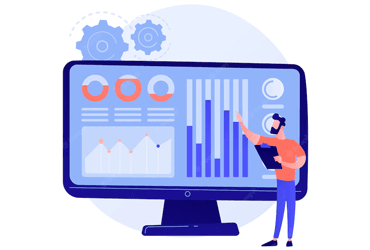
 Feb 24, 2022
Feb 24, 2022
Every organization has many businesses and systems that work individually and interdependently to achieve a set of goals, and system analysis is the detailed evaluation of a particular system to identify areas for improvement and make any improvements if necessary, and this includes; Gather the requirements of the company and research the path that must be taken to activate these requirements. The ultimate goal is to have a complete operating system in place that provides efficiency and reliability for the organization. The question often asked regarding system analysis is “What are the benefits of system analysis?”.
When the system analysis is done properly, it makes sure that the right track is followed in terms of the applications and helps reduce errors which reduce future IT requirements to fix the issues. If the above process is done correctly, it will not only save the company money up front, Rather, it ensures that the correct application path is taken the first time, growth and business costs considerations have been taken into account to accommodate future plans, and errors are kept to a minimum thus mitigating the requirements for comprehensive IT reform in the future.
The goal of system analysis is to help design systems where sub-systems may have conflicting goals, and system analysis helps achieve interoperability and sub-system unity.
Systems analysis is the path towards system observation for investigation or improvement purposes. It is applied to information technology, where computer-based systems need to be examined according to their structure and plan. In IT, systems analysis can include a quick look at the end customer's use of a product package. or an item; Take a peek from top to bottom at the source code to characterize the systems used in building programming.
Both inside and outside the business world, system analysis experts are regularly asked to critically look at and redesign systems or suggest changes as vital. Systems analysis helps assess whether a system is feasible or effective within its overall design and helps reveal alternatives to the recruitment industry Or another party, and accordingly, system analysis is unique to system administrators, who maintain systems every day, and their roles usually include a high-level perspective on the system to determine its general applicability according to its plan.
Systems analysis helps in planning systems where sub-systems may have conflicting directions and enables understanding of complex structures, similarly, systems analysis helps in achieving burial similarity and solidarity of sub-systems.
Systems analysis also gives a positive attitude towards the assimilation and comparison between the capabilities of the sub-systems and the complete system.
Now, here we will take a peek at some of the systems analysis tools and techniques, which are:
Network diagrams are an equal strategy for talking about the relationship between two arrangement of elements, where network diagram analysis is valuable in eliminating useless reports or redundant information from reports.
It can also be used to distinguish between the commitments of different managers to a particular subsystem, and also, network charts can be used effectively to keep track of the flow of different exchanges and reports in an association.
Simulation involves developing a numerical model in general, in contrast to legitimately depicting the general behavior of a system, a simulation model depicting the activity of the system as much as the individual events of the individual parts of the system.
Thus, simulation in general is nothing more or less than a way to perform test runs on a system model.